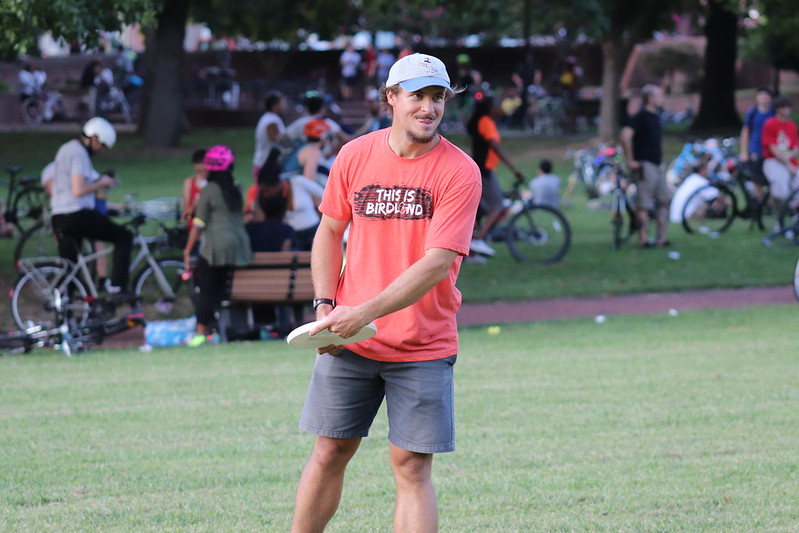Skill One ForehandCues For throwing the Frisbee:
1. Make a peace sign, then turn hand so palm is up. 2. Hold frisbee with peace sign, thumb on outside/top. Curl the rest of the fingers into your palm. 3. Elbow in (but not tight), palm up, face target. 4. Step toward target with the opposite foot you hold the frisbee with, snap wrists and fingers on follow through. 5. Keep palm up throughout throw (most common error). |
Skill Two BackhandCues for Throwing the Frisbee:
1. Hold the frisbee with the hand you write with. 2. Place the index finger along the edge, thumb on top and the other three fingers holding the edge of the disc. 3. The shoulder of the hand you are throwing with should face your target. 4. Bring the disc towards the body by curling the throwing arm making sure to keep the disc level. (Frisbee back pocket - hand to target) 5. Extend the arm and snap at the wrist (still keeping the disc level) the foot you step with is the same as you hold the disc with. 6. Step towards your target with the same foot you throw with. |
Terminology & EtiquetteTerminology:
1. Par - the score established as the number of strokes or throws it should take to complete the hole. 2. Birdie - one stroke or throw less than Par. 3. Eagle - two strokes or thows less than Par. 4. Bogie - one stroke or throw more than Par. 5. Double Bogie - two storkes or throws more than par Ettiquete 1. Stay quiet when someone is throwing. 2. Don't walk in front of someone throwing. 3. Don't throw into a group in front of you. 4. Be Honest about your score |
HISTORY
The sport was formalized in the 1970's, and shares with "ball golf" the object of completing each hole in the fewest throws. A golf disc is thrown from a teeing area to a target which is the "hole" (PE classes used a hula hoop). As a player progresses down the fairway, he or she must make each consecutive throw from the spot where the previous throw has landed. Finally, the "putt" lands in the basket (hula hoop) and the hole is completed. On completing a hole, the player proceeds to the teeing area of the next hole, honors to the player with the lowest score until all holes have been played.
Disc golf shares the same joys and frustrations of traditional golf, whether it's sinking a long putt or hitting a tree halfway down the fairway.
Disc golf can be played by anyone from childhood through senior years, making it one of the greatest lifetime fitness sports available. Specially-abled and disabled participate, giving them the opportunity to take part in a mainstream activity.
Disc golf provides upper and lower body conditioning, aerobic exercise, and promotes a combination of physical and mental abilities that allow very little risk of physical injury.
A professional quality disc costs less than $15, and it only takes one for basic play.
There are 5985 disc golf courses in the USA as of 2019, in large cities and small towns alike.
The Professional Disc Golf Association provides a Course Directory on their website, www.pdga.com, to find the closest courses near you.https://www.pdga.com/files/pdgawcteachingpacket.pdf
The sport was formalized in the 1970's, and shares with "ball golf" the object of completing each hole in the fewest throws. A golf disc is thrown from a teeing area to a target which is the "hole" (PE classes used a hula hoop). As a player progresses down the fairway, he or she must make each consecutive throw from the spot where the previous throw has landed. Finally, the "putt" lands in the basket (hula hoop) and the hole is completed. On completing a hole, the player proceeds to the teeing area of the next hole, honors to the player with the lowest score until all holes have been played.
Disc golf shares the same joys and frustrations of traditional golf, whether it's sinking a long putt or hitting a tree halfway down the fairway.
Disc golf can be played by anyone from childhood through senior years, making it one of the greatest lifetime fitness sports available. Specially-abled and disabled participate, giving them the opportunity to take part in a mainstream activity.
Disc golf provides upper and lower body conditioning, aerobic exercise, and promotes a combination of physical and mental abilities that allow very little risk of physical injury.
A professional quality disc costs less than $15, and it only takes one for basic play.
There are 5985 disc golf courses in the USA as of 2019, in large cities and small towns alike.
The Professional Disc Golf Association provides a Course Directory on their website, www.pdga.com, to find the closest courses near you.https://www.pdga.com/files/pdgawcteachingpacket.pdf

